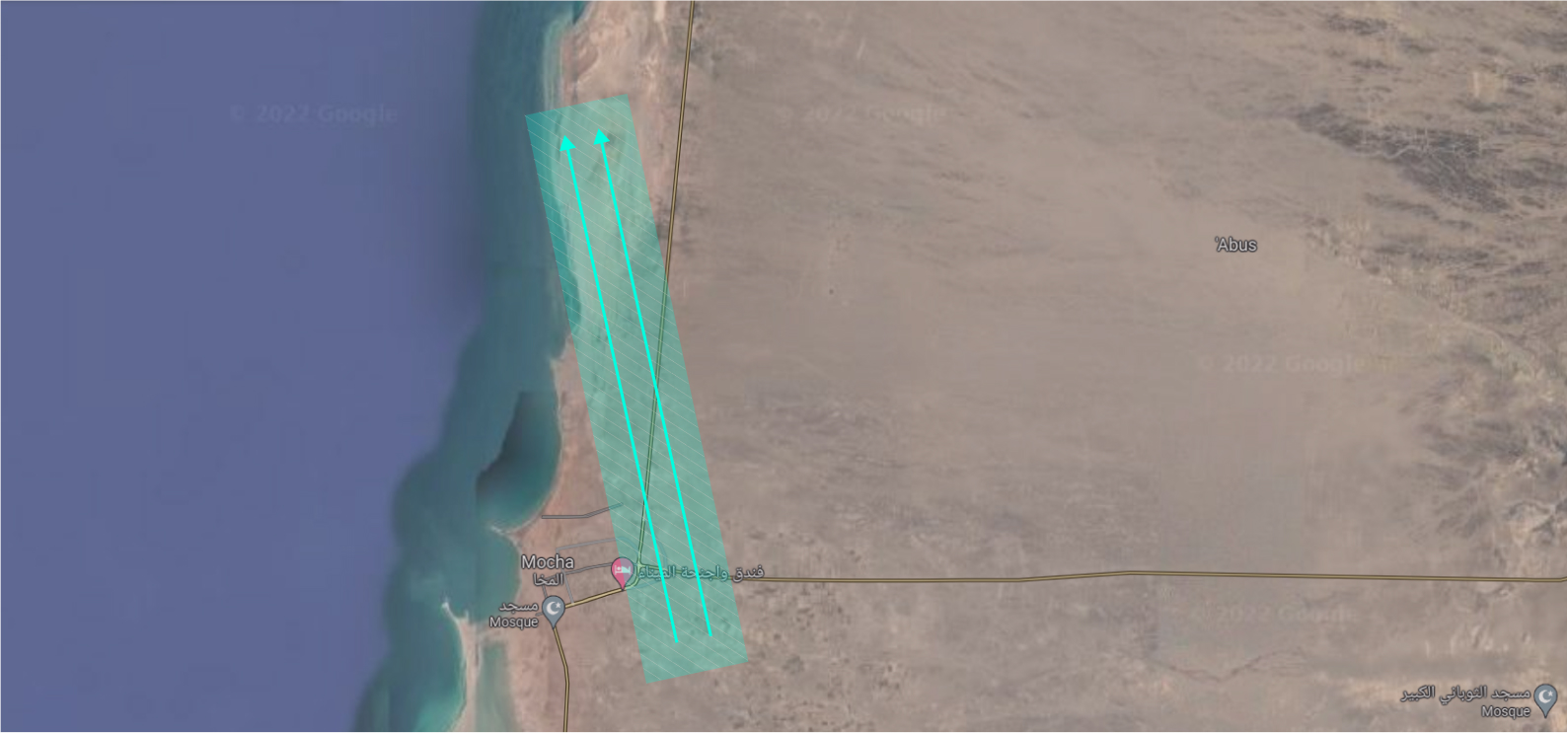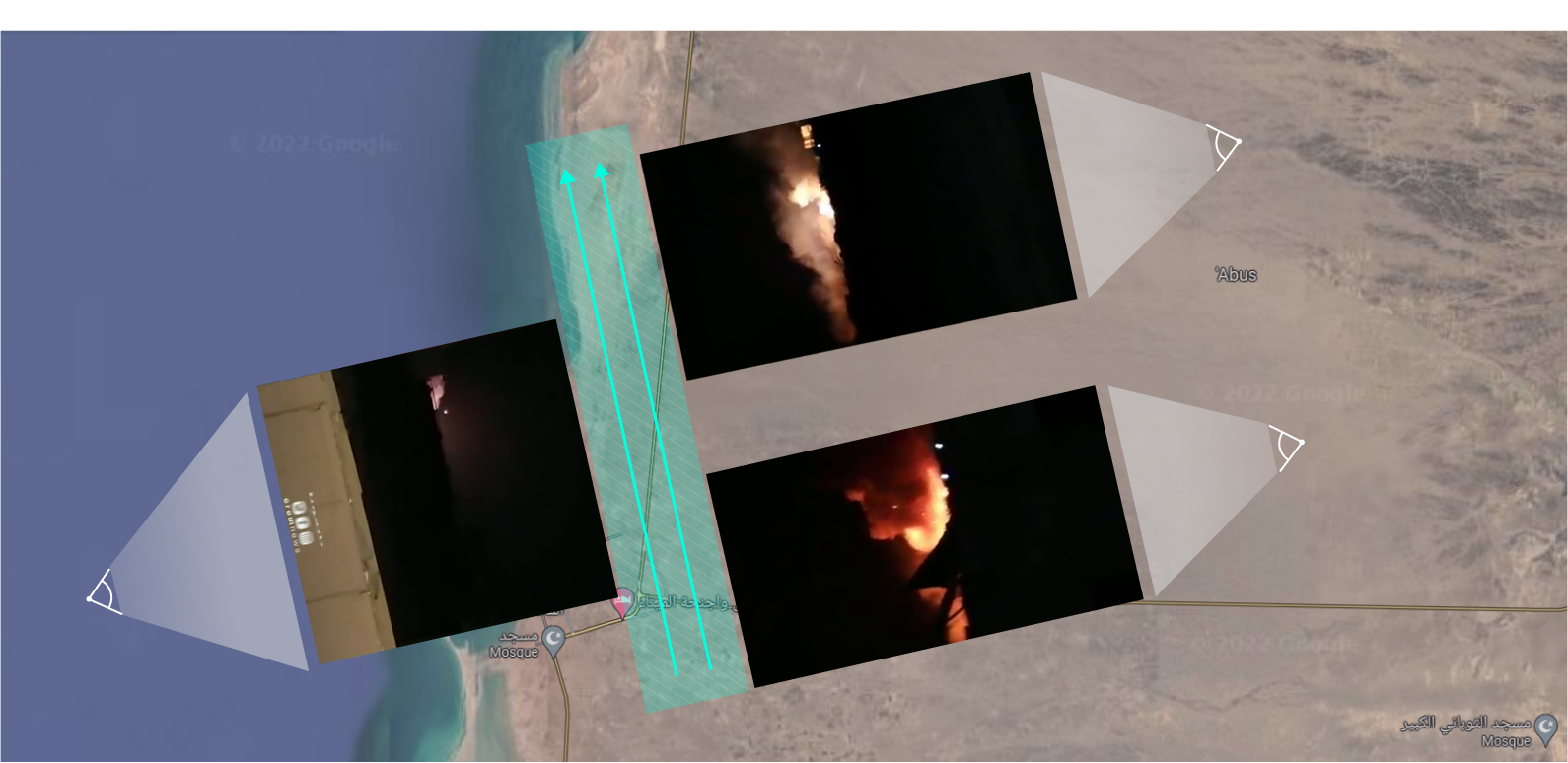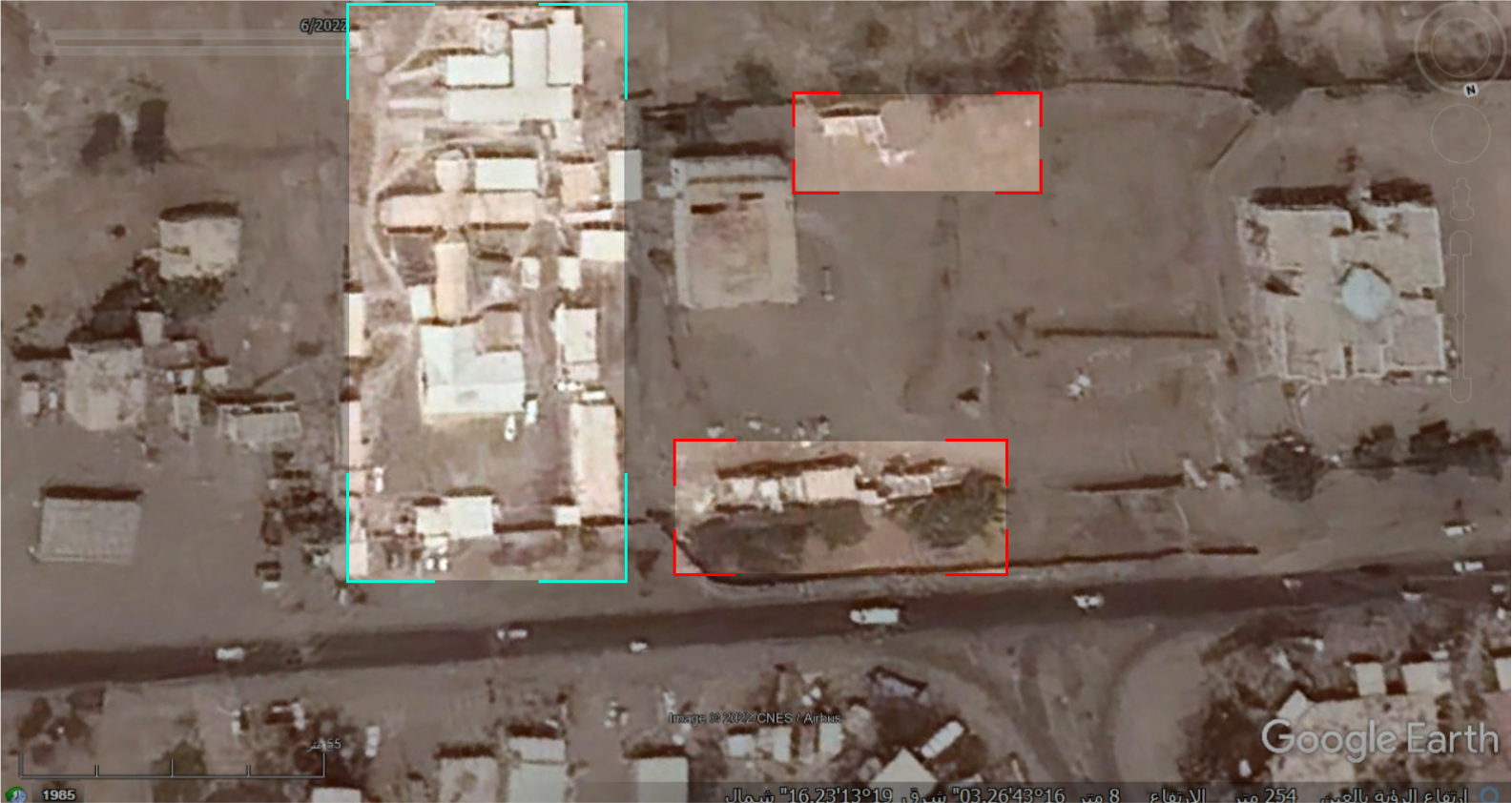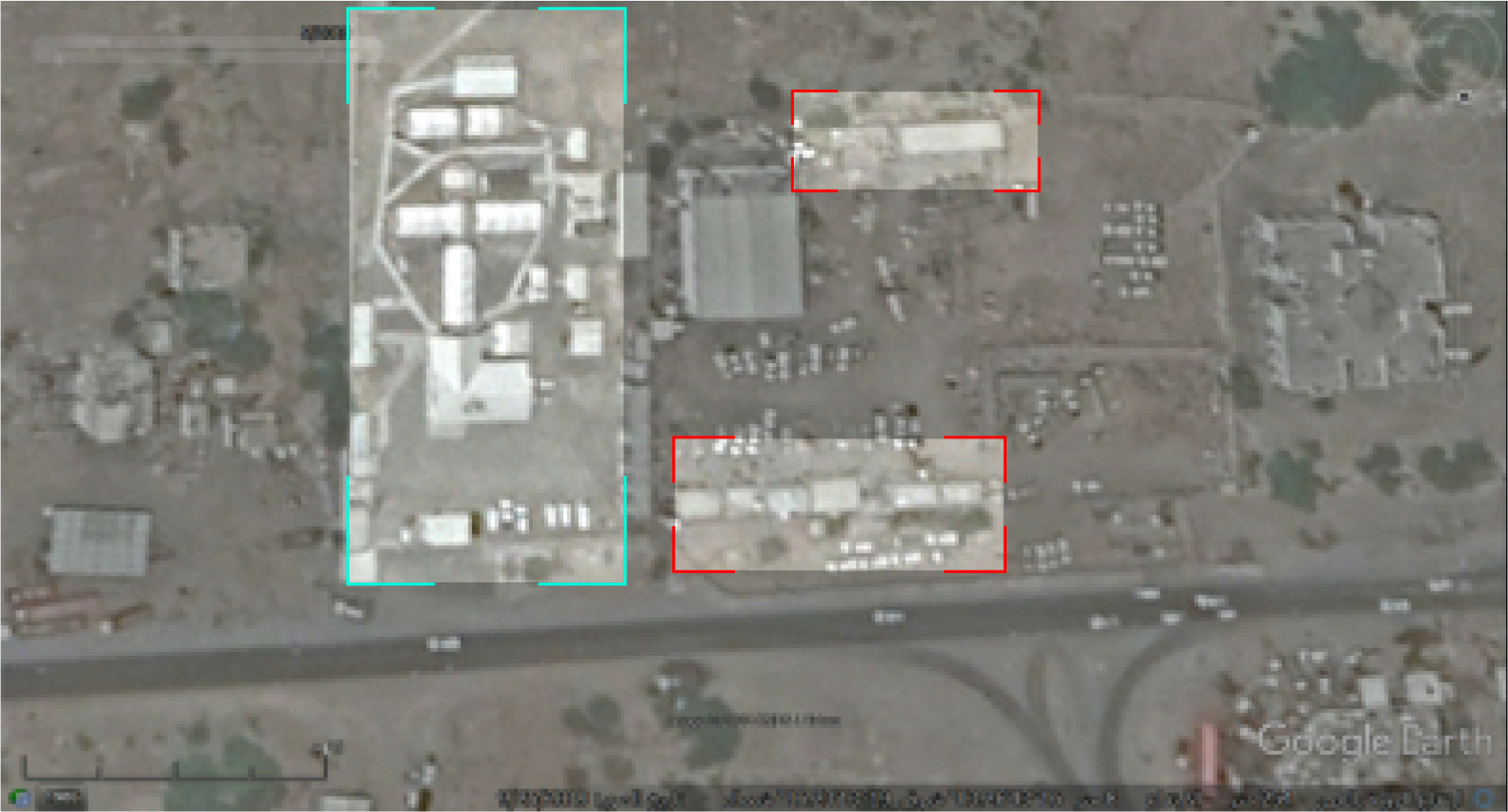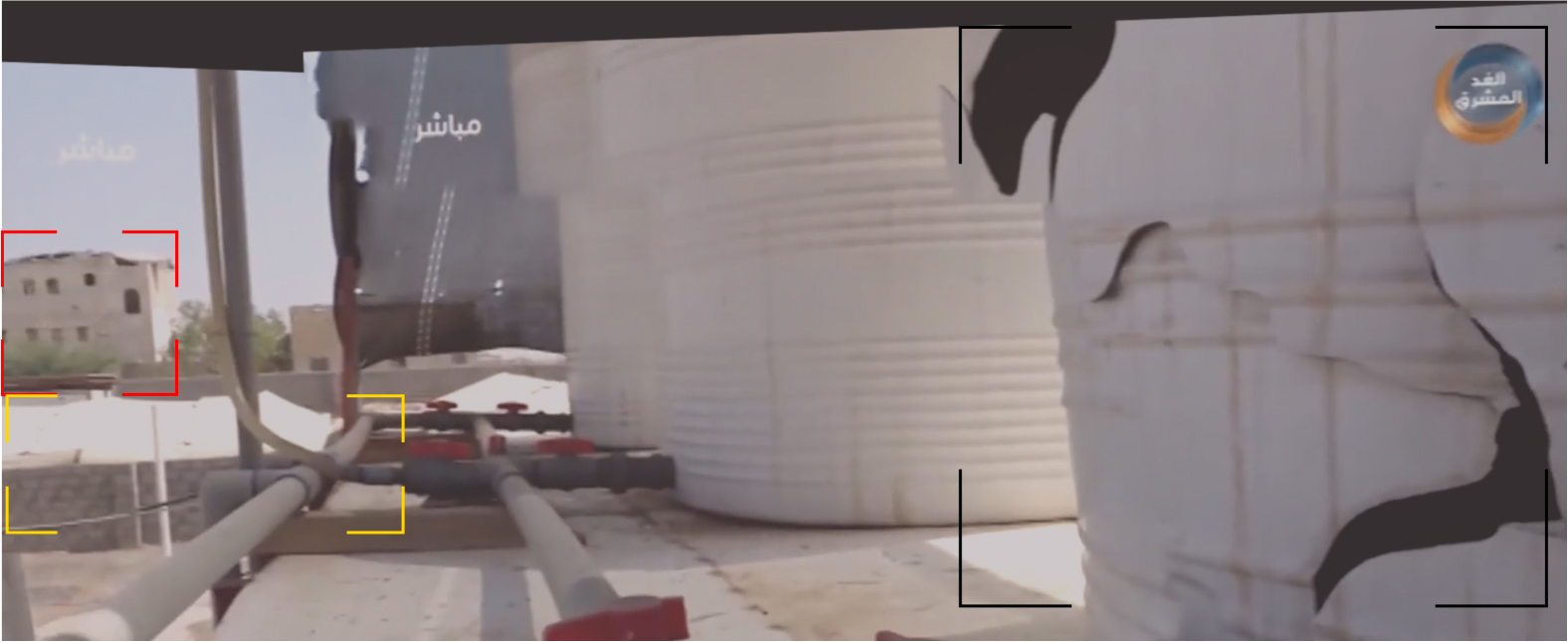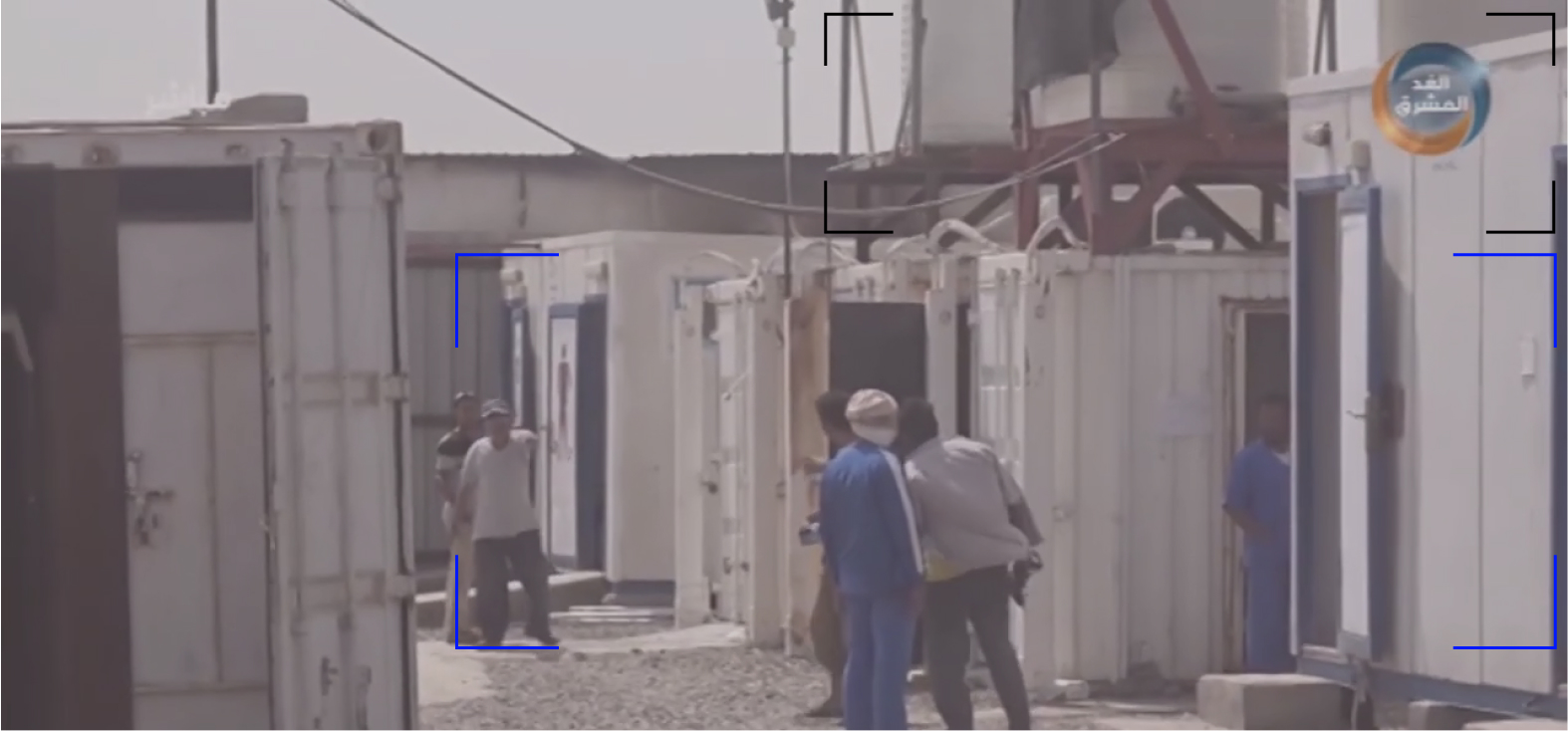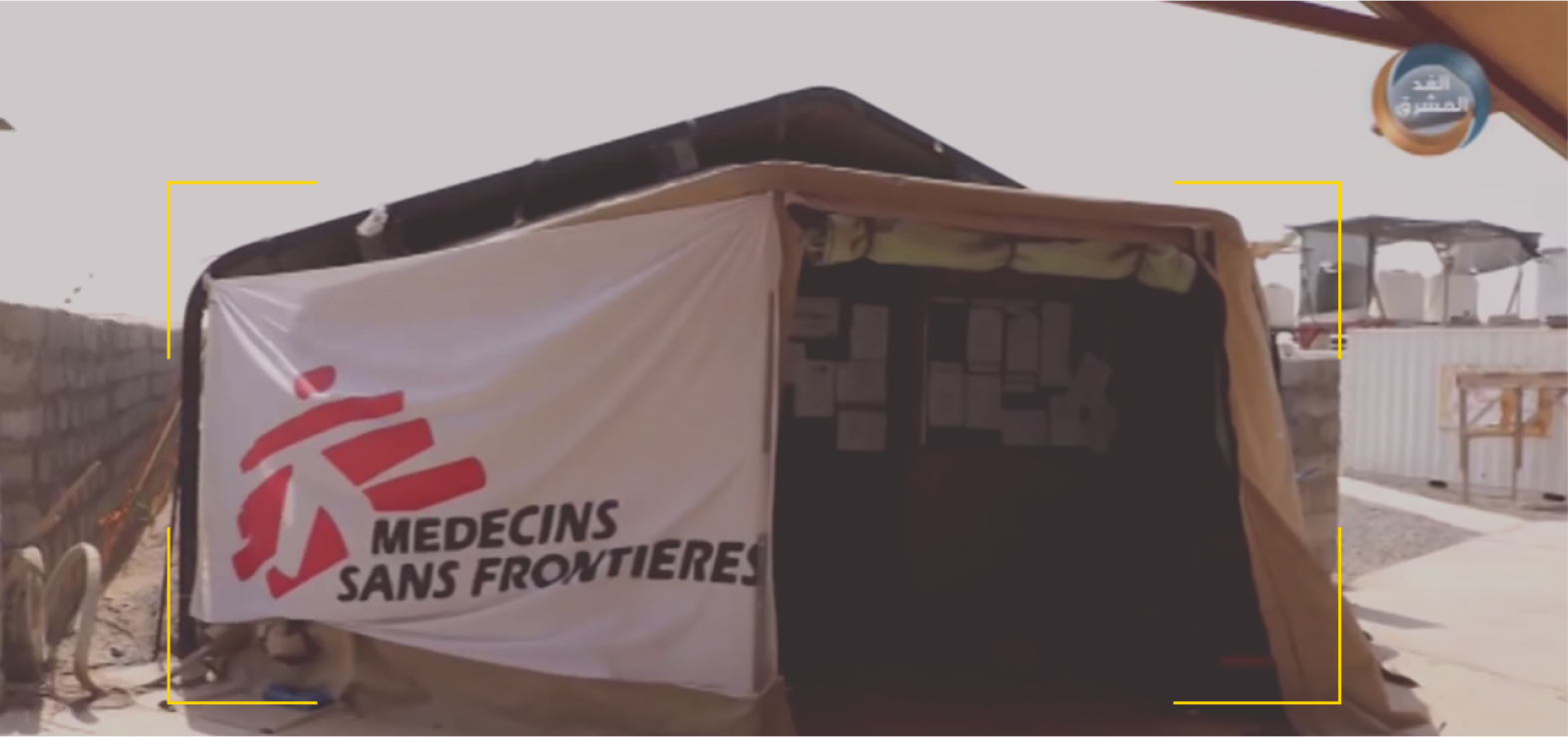INVESTIGATIONS
MSF hospital partially destroyed
December 23, 2022Print Article
- Introduction
- Methodology
- The impacted area
- The Joint Forces
- What happened (and when)?
- Conflicting reports
- Impact sites
- Information from Google Maps
- Daytime visual content
- Night visual content
- Impact analysis
- Probable responsibility
- Missiles and Drones
- Military camp next to a hospital
- MSF
- Visual content verification
- Victims
- Legal framework:
- Civilian objects are protected under international law
- Chronology of events related to the nature of the targeted site and MSF hospital location
- Conclusion
Table Of Contents
- Incident: MSF hospital partially destroyed
- Type: Collateral damage (explosion of a military warehouse)
- Location: Al Mocha city, Taiz governorate
- Date: 6 November 2019
- Time: between 06:00 and 07:51 pm
- Casualties: No casualties were reported
- Probable munitions: burning objects or ammunition
- Probable responsibility: Houthi “Ansar Allah” forces
Introduction
A hospital run by Médecins Sans Frontières-MSF (Doctors without Borders), in Al Mocha city, west of Taiz governorate, was partially destroyed by ammunition or burning objects that flew from nearby military sites and warehouse, after missiles and drone attacks by the Houthis on the military supply camp in Al Mocha city on the evening of 6 November 2019.
Methodology
This investigation is based on multiple stages of analysis and verification of available sources, by the Yemeni Archive investigation team. The integrated sources provided the team with information related to the date, time, location and damage caused by the attack. By examining all available information, Yemeni Archive has developed an understanding of the incident and the possible perpetrators.
● Analysing and verifying 50 sources in videos, photos and reports related to the incident and published on social media. The sources showed the location of the impact, the first moments of attack, the trajectory of the shells, the destruction, and the distribution of military forces in the region.
● Determining the location of the impact by matching the visible landmarks in the visual content with satellite images and the first reports of attack.
● Analysing satellite images that show the location, in addition to videos showing the targeted location before it was bombed.
● Analysing the visual and audio content that shows the accent of the people in the content, the spatial description, in addition to the nature of the target place.
For more details of the research methodology in Yemeni Archive, please visit our website.
The impacted area
Al Mocha was a starting point for Saudi-led coalition backed Joint Forces to advance towards the centre of Al Hodeidah Governorate. Al Mocha was the city from which the Forces announced the “start of the battle to liberate Al Hodeidah” 12 June 2018.
On 2 August, MSF announced the opening of a surgical field hospital in Al Mocha 180 kilometres south of Al Hodeidah “to respond to increased medical needs”.
The coastal city of Al Mocha, located on the Red Sea coast, west of Taiz Governorate, has a strategic importance in Yemen, along with its seaport. It gained its importance early in the Yemeni war for its location role in controlling and securing the international maritime corridor in the Red Sea and Bab al-Mandab Strait. In November 2014, the Houthi “Ansar Allah” forces took control of the city to be a starting point for controlling Bab al-Mandab Strait, and moving towards Aden governorate, and the rest of Taiz governorate.
After the Houthi forces retreated from Aden, Saudi led coalition backed forces moved along the coastal strip of Yemen from the governorates of Aden and Lahj to Bab al-Mandab Strait in Taiz Governorate and took full control of Al Mocha city in February 2017. The coalition backed forces used the city as a centre for headquarters for command and a gathering area for military forces.
During the battle of Al Hodeidah between June and before signing the Stockholm Agreement on 13 December 2018, under the auspices of the United Nations, which called for an immediate cease-fire in Al Hodeidah city, the battle for Al Hodeidah took an upward turn. Al Mocha city remained a target for Houthi projectiles, given its military importance to the attacking forces.
The Stockholm Agreement led to a ceasefire between Yemen’s warring parties in and around Al Hodeidah city at the end of 2018. While the Agreement was still in force, the two warring parties exchanged accusations of violating the truce. In one incident, missiles hit Al Mocha city, which was headquarters for the Joint Forces. The coalition air defence systems were unable to stop the projectiles. One of the Houthi attacks hit sites near MSF hospital, partially destroying it.
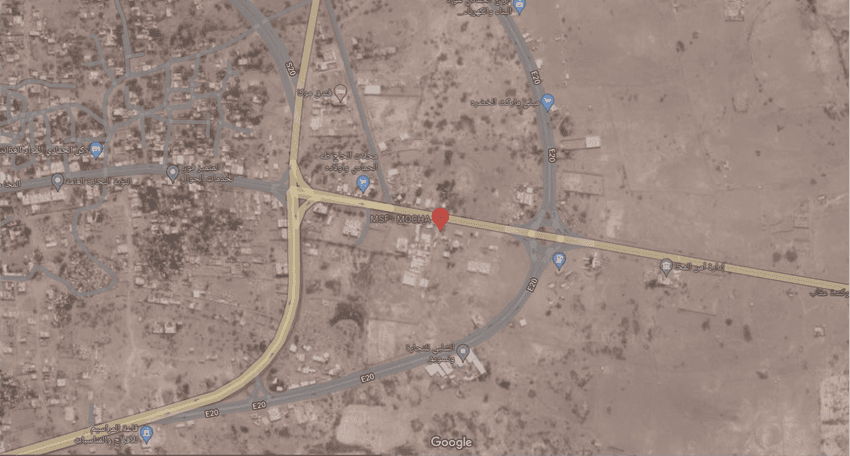
A satellite image from Google Maps of the location of the MSF-run hospital in Al Mocha city, Taiz governorate.
The Joint Forces
The Joint Forces is a military entity that includes all the military formations in the western coast of Yemen under a joint supreme command and an operations room linked to the Saudi led coalition forces, including the Southern Giants Brigades. These forces receive direct support from the coalition, specifically from the UAE. They were not represented in the Ministry of Defence in the official structure of the Yemeni government until April 2022, after the formation of a presidential leadership council in Yemen, which included the commander of the Giants Brigades, Abdul Rahman al-Muharami, nicknamed “Abu Zara’a al-Muharrami.”
What happened (and when)?
On the evening of 6 November 2019, social media users reported that Al Mocha city, west of Taiz governorate, had been hit by ballistic missiles, and drones that hit separate military and civilian sites in the city, including an MSF hospital.

A screenshot of a tweet by Khabar News Agency
A video by Yemen Today TV showed that the air defence system of the Saudi led coalition in Al Mocha intercepted missiles in the city. The video was dark and did not show any fires or explosions. The first report about the attack was published by Al-Miqdad Al-Mahmoudi Facebook post at 07:01 pm, according to the timestamp analysis of the post.
A video by Yemen Today TV showed that the air defence system
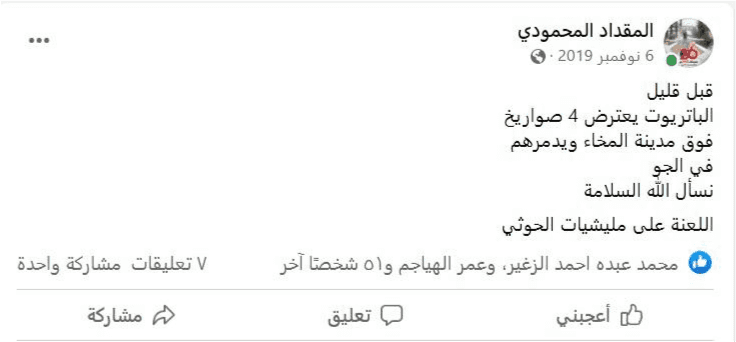
A screenshot of Al-Miqdad Al-Mahmoudi Facebook post

a screenshot of the post timestamp
About 50 minutes later, it was reported that the warehouses of the Military Supply Department of the Giants Forces in Al Mocha were targeted by a drone. This was followed by reports showing fire and explosions in Al Mocha, with munitions flying in several directions into the city. In the videos shot from distance, the sound of projectiles falling can be heard near the location from where the video was shot.
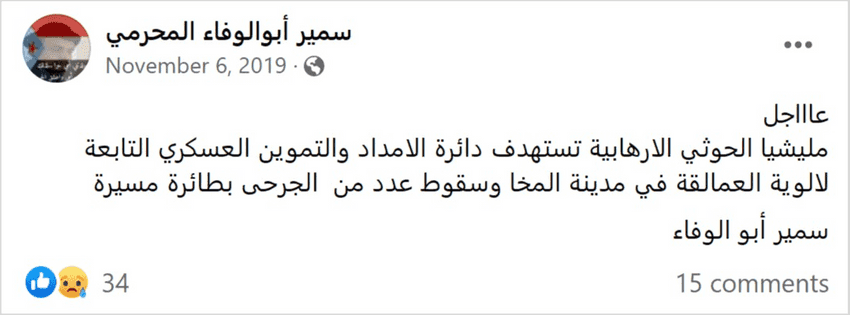
A screenshot of Samir Abu Al-Wafaa Al-Muharrami’s Facebook post
Video by Al-Omana net showing fire and explosions in Al Mocha
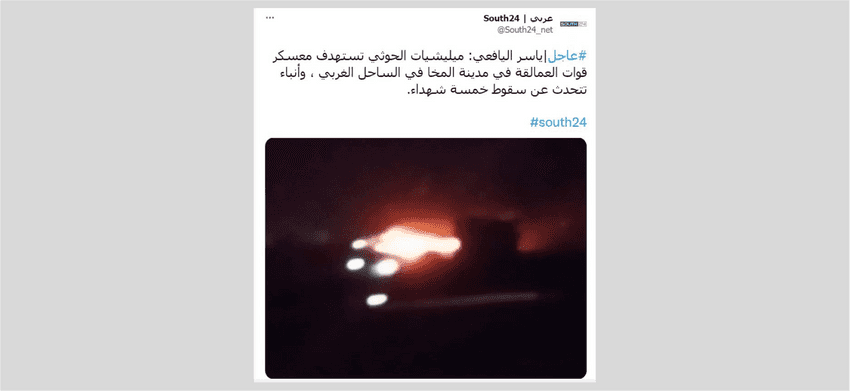
A screenshot of a tweet by Arabi - South 24 of the attack on the Giants Forces camp in Mocha
The probable time of the attack can be estimated according to the chronology of the reports along with the time of nightfall in winter in Mocha city via the Sun Calc tool which is 06:00 pm on the day of the attack. The attack occurred between 06:00 and 07:51 pm on 6 November 2019.
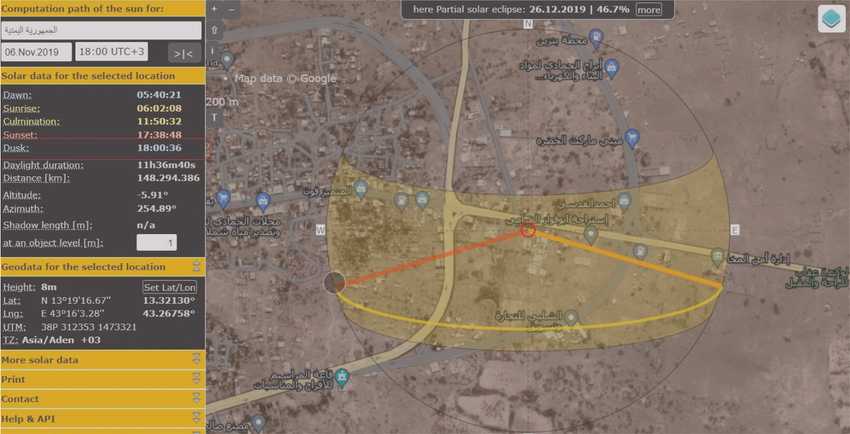
A screenshot from the Sun Calc tool, showing the time of nightfall in Al Mocha on 6 November 2019
Conflicting reports
Several sources claimed that the attack hit an MSF hospital, as well as residential neighbourhoods and a displaced persons camp. Some sources reported that the attack targeted weapons warehouses in the government compound of Al Mocha. Other sources said the attack targeted the armament headquarters of the coalition and the Giants Brigades. Despite conflicting information about the location of the bombing, most sources agree that a weapons warehouse was attacked.
A screenshot of Al-Mashhad Al-Shabwani Facebook post. It mentioned that weapons warehouses in the government complex in Al Mocha city and MSF camps were targeted by Houthi drones

A screenshot of a tweet by Yemen Today TV reporting that a drone hit a hospital affiliated with MSF in Al Mocha city
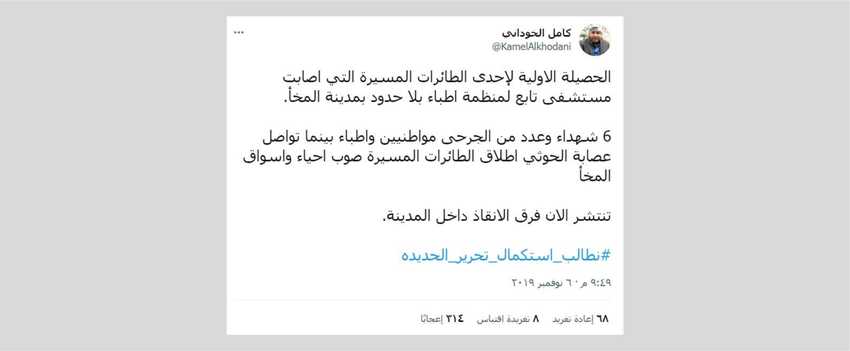
A screenshot of a tweet by Kamel El Khoudani, reporting that a drone hit a hospital affiliated with MSF in Al Mocha city
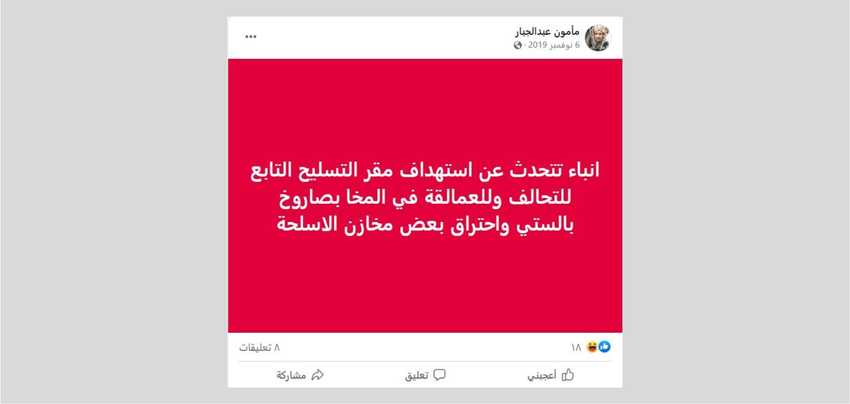
A screenshot of Mamoun Abdul-Jabbar Facebook post reporting about the targeting of the armament headquarters of the coalition and the Giants forces in Al Mocha with a ballistic missile
Although contradictory, the available information, and the different descriptions of the targeted site by the sources, help in reaching an accurate conclusion about the nature and location of the impact site, based also on the visual evidence related to the incident that was documented in the evening of the day of the attack and the morning of the next day.
Impact sites
The various sources of information, information from Google Maps, visual evidence of day and night, and satellite images helped verify the impact site of the accident.
Information from Google Maps
When searching for the government complex of Al Mocha and the MSF hospital in Google Maps, we find that they are close to each other, separated by only about 150 meters, at the eastern end of the city, along the main road of Al Mocha leading to the centre of Taiz governorate. The government complex coordinates: 13.321237, 43.266472, and the MSF Hospital coordinates: 13.321049, 43.268049.
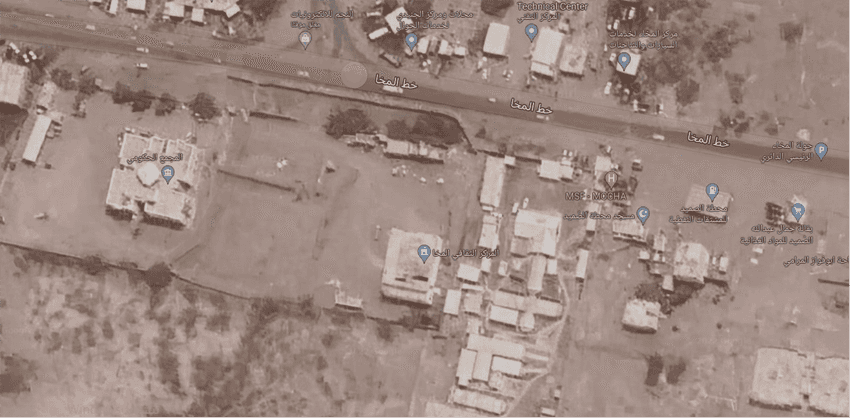
A satellite image from Google Maps showing the location of the government compound and the MSF hospital in Al Mocha
Determining the location of the hospital and the government compound is a helpful step in narrowing the scope of the search for the location of ammunition warehouses and camps, which most of the reports agreed that they were bombed in the vicinity of the two sites.
Daytime visual content
On the next day of the attack, videos showed several sites that were damaged by the bombing. By comparing a screenshot from a video published by Euronews on YouTube with a video published by MSF, we were able to verify that the hospital mentioned in the open source information is located in the aforementioned coordinates in Google Maps.
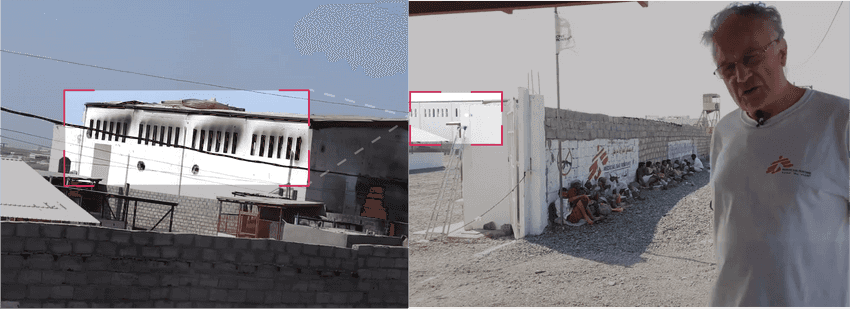
Screenshots from Euronews and MSF videos about Al Mocha Hospital on YouTube
The visual evidence shown in videos published by Euronews, the Giants Brigades Media Centre, and Yemen Today TV also matched the location details in satellite imagery from Google Earth.
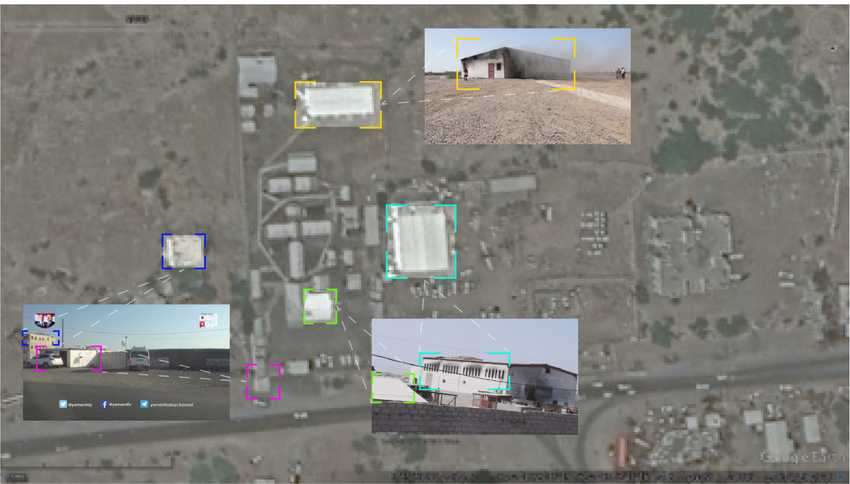
Screenshots from videos by Euronews, Giants Brigades Media Centre, and Yemen Today TV
The second site of impact shown in Euronews, the Giants Brigades media centre, in addition to the video of News Yemen on YouTube, is located approximately 130 meters north of the hospital at coordinates: 13.321901, 43.266966.
Screenshots from Euronews, Giant Brigades Media Centre and News Yemen YouTube
By comparing clear landmarks that appeared in a screenshot from News Yemen video with satellite images in the vicinity of the hospital, it becomes clear that the third site is not far from the previous site, and is located in a different direction, approximately 400 meters east of the hospital, at coordinates: 13.321868, 43.264900.
A satellite image from Google Earth, and a screenshot from News Yemen YouTube showing the third site.
A satellite image from Google Earth of the impact sites shown by the visual content. MSF hospital in red and two civilian sites in blue and yellow
Night visual content
The night visual content on social media platforms showed explosions that night. We considered the possibility of posting videos unrelated to the incident, so we checked all visual and audio content used in the investigation under a separate section.
We analysed wind direction in Al Mocha as a focal point to determine the location from which the three different videos were shot, and to check that the description of the explosions locations in the open source information and the visual content matches. Two videos were published by Muhammad Yahya Al-Dakhin on Facebook, and a third was published by Erem News on Twitter.
A screenshot from ZOOM Earth showing the wind direction in Al Mocha city at the time of the attack, heading to the northwest
A satellite image from Google Earth. Two blue lines drawn to indicate wind direction based on ZOOM EARTH information, and screenshots from Muhammad Yahya Al-Dakhin and Erm News videos placed according to view of smoke from inside Al Mocha
This shows two possible directions for filming, east and west of the smoke source, heading north with a slight western inclination. In the first video of Erm News, dirt berms made of textile boxes appear in front of the photographer, along with a house that does not seem clear due to various factors (imaging quality - darkness - distance). The explosions and the berms shown in the videos suggest that the first video location in the west was a camp, which we verified by comparing visual evidence and the camera angle with satellite images from Google Earth. It a military location at coordinates: 13.309469, 43.256113
A screenshot from Erm News video on Twitter, a satellite image from Google Earth
From the east side of the smoke, a 12-second video posted by Muhammad Yahya Al-Dakhin on Facebook shows a vehicle that lit the road for about a second, indicating the direction of traffic, along with the sidewalk separating the two directions of the road, and a large building next to the explosions. The visual evidence matches exactly the location of the smoke. On the northern road (E20) located at coordinates: 13.323349, 43.270675. The building that appeared at the moment of the explosions’ glow was the Government complex building.
Screenshots from a video posted to Facebook by Muhammad Yahya Al-Dakhin. A satellite image from Google Earth of the filming location based on the visual evidence in the video
When examining the third video, we see that the angle of its filming is the same angle as the filming of the second video, with a slight difference. The same lights appear in the two videos, but the third filming site is located a little further in a house in the vicinity with coordinates: 13.327204, 43.272020 north of the site of the explosions.
Screenshots from two of the videos of Muhammad Yahya Al-Dakhin on Facebook. The two images on the right (red frame): the angle of shooting matches. The two images on the left (blue frame): the lights appear in the two videos
A satellite image from Google Earth, showing a possible third filming location, along with a possible second filming location
The lines depicting the filming angles intersect based on the analysis of the three filming sites in the area between the government compound and the MSF hospital at coordinates: 13.321153, 43.267223
A satellite image from Google Earth showing the intersection of the lines depicting the filming angles from the three analyzed sites in the area between the government compound and the MSF hospital
In the satellite images taken the day after the attack via Sentinel Hub website, we see a black spot in the specified area, and images from Google Earth show great damage to buildings, as well as a crater at the site of one of the buildings. This confirms that the buildings and the area between the compound and the hospital are the supply and military supply warehouses of the Giants Brigades, which were the source of the explosions only 50 meters from the MSF hospital.
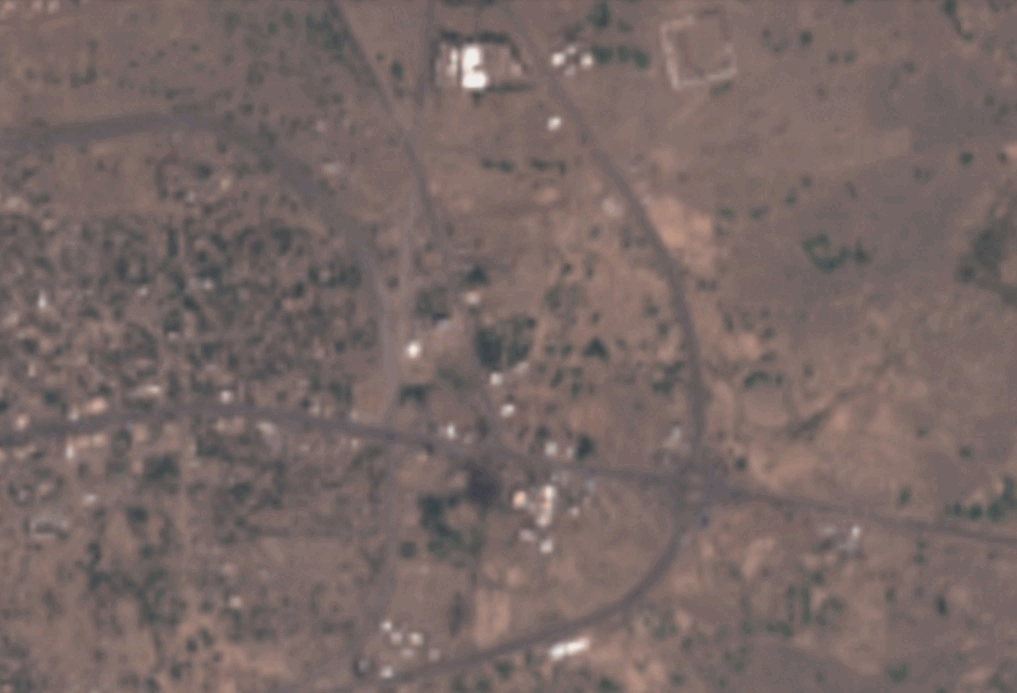
A GIF made from two satellite images from the Sentinel Hub on 2 and 7 November 2019, showing the impact of the explosions in the adjacent buildings of the MSF hospital
Satellite images from Google Earth before and after the attack showing the damage to the buildings next to the MSF hospital and the crater. Red: ammunition warehouses. Green: MSF hospital

Image of a distance measuring tool from Google Earth, showing the distance between the ammunition warehouses and the MSF hospital of about 50 metres
Impact analysis
MSF published on its official website a photo taken the morning after the explosions showing the destruction of a facility inside the hospital complex - it did not specify the type of facility damaged. The MSF hospital in Al Mocha is a field hospital made up mostly of tents and a yard.
By comparing the features shown in the photo with a screenshot from an MSF video filmed before the attack we see the destroyed facility located in the far northwest within the walls of the hospital, next to the ammunition warehouses.
A screenshot from a video and photo posted by MSF on its website and YouTube channel
A satellite image from Google Earth, showing the location of the damaged facility shown in the MSF photo
In the photo, the facility appears to be exposed to a fire, and it also shows iron bars bent in a way that suggests that a heavy, burning or charred object that was emitting smoke fell without exploding in the place. We cannot see fragments or holes in the walls adjacent to the facility and the cloth tent. This suggests two possibilities for the main reason for the damage: the first is that a burning projectile that does not contain an explosive device fell on the facility, and the second is that a burning object such as an iron bar or a piece of wood … etc fell on the facility.
A photo of the impacted facility. The red arrow shows the location of the possible fall of the flaming object. The yellow colour shows the walls and the cloth tent without holes caused by explosions
The water tanks of one of the hospital facilities were also damaged. By analyzing visual evidence from Al-Ghad Al-Mushreq TV video, the tanks can be seen on containers to the west of the hospital. The water tanks were damaged perhaps by shrapnel or other objects.
Screenshots from Al-Ghad Al-Mashreq TV YouTube video of damaged water tanks in one of the hospital’s facilities.
A satellite image from Google Earth, showing the location of the water tanks and the trajectory of the object that hit the tanks, based on visual evidence from the Al-Ghad Al-Mashreq TV video
The hospital’s most damaged facility was a building south of the hospital, probably the pharmacy - judging by the interior decoration and burnt objects. In the visual content of Al-Ghad Al-Mashreq TV video, we can see two holes in the building, one in the cement wall, and the other in the roof.
A screenshot from the Giants Brigades Media Center YouTube video of one of the damaged warehouses of medicine and medical equipment in MSF hospital
Screenshots from Al-Ghad Al-Mashreq YouTube video, showing the two holes in one of the hospital’s facility buildings
We created a panoramic image of the building from the inside and outside from Al-Ghad Al-Mashreq YouTube video. We see fire impact without shrapnel in the inner and outer walls.
A panoramic image from Al-Ghad Al-Mashreq video on YouTube of the damaged building from the inside, showing that there are no shrapnel impact on the walls
A screenshot from Al-Ghad Al-Mashreq video of the side hole from the outside
In addition to the previous facilities, the hospital’s electric power generator was damaged, according to an MSF statement. The damage did not appear in the visual content related to the accident, and the generator appeared only in quick shots from distance. The shots help locate the damaged facilities inside the hospital, and with locating other facilities outside the hospital we can get an idea of some of the impact of the explosions.
A screenshot from the Media Center of the Giants’ Brigades video showing the location of the hospital’s electrical generator, in addition to the impact of the warehouse explosions on the former cultural centre building located with ammunition warehouses surrounded by the same wall
A satellite image from Google Earth, showing the sites impacted by the explosions in the vicinity of the munitions warehouse
We see in the night videos that documented the explosions that there is an area on fire and smoke rising north and south of the site of the explosions. When projecting the two sites onto the sites impacted by the attack, we find that the burning area is located in the same place as the oil derivatives tank north of the ammunition warehouse, and the rising smoke is coming from the direction of the hospital. It is likely that the smoke is coming from the hospital facility (pharmacy).
A screenshot from Muhammad Yahya Al-Dukhin Facebook video
Screenshots from Euronews, the Media Center for Giants Brigades on YouTube, and Mohammed Yahya Al-Dukhin on Facebook. A satellite image from Google Earth
Given the direction of the munitions flying from the warehouses in all directions, including towards the MSF hospital, as shown in the night video, in addition to the fall of unexploded ordnance inside the hospital, it is likely that the damage to the hospital was caused by flying munitions or objects, and there are no indications that there was a direct targeting.
A video by Mohamad Yehya Al Dakheen shows shrapnel flying in all directions.\
Probable responsibility
The attack was not claimed by any party. In a statement, the Joint Forces in the Western Coast accused Ansar Allah forces of targeting the MSF hospital.
static/assets/msf_stetment_22.png
A statement by the Joint Forces on the attack of Al Mocha, from Aden Al-Ghad Newspaper Twitter
Missiles and Drones
The Joint Forces accused the Houthis of firing ballistic missiles and drones at Al Mocha city. In conjunction with the attack, it was reported that the Houthis had cut off the road to Al Waziyah junction that leads to the centre of the district, and that they had fired several missiles towards Al Mocha, according to Zeyad alJaberi tweet at 07:22, i.e. 20 minutes after the first report of the interception of missiles in Al Mocha sky.
A screenshot of Zeyad alJaberi tweet
Minutes after Zeyad’s tweet, Ramze alMamari tweeted stating that he had seen three red balls launched from distance, wondering if they were missiles. A user responded saying that he saw the missiles from Al-Mawjod area - meaning Al-Amjod - in Sharaab Al Salam district.
A screenshot of Ramze almamari’s tweet and responses
We checked the areas mentioned in previous tweets and responses using Google Earth and Open Street Map. We found all the areas in one direction east of Al Mocha. It is possible to see the missiles from the two areas in case the missiles were launched - as they say - from the east, and these are areas under the control of the Houthi Ansar Allah forces.
Image created from Google Earth and Open Street Map. Red circle: Al Waziyah junction, red square: the road leading to Al Waziyah junction, blue circle: Al Amjod area in Sharaab Al Salam district, Taiz governorate, yellow circle: Al Waziyah district, Taiz governorate, green circle: Al Mocha city, yellow triangles: the area that the missiles can be seen from.
The visual content in Euronews YouTube video shows the wings of a drone that matches the Qasef-1 drones owned by the Houthis, which is a similar version of the Iranian Ababil drones.
Screenshots from Euronews YouTube video showing the drone used in the attack on Al Mocha on 6 November 2019.
Screenshots from videos by Al-Mayadeen TV and the Houthi-affiliated War Media
A photo from the Iranian news agency IRNA showing the Iranian Ababil type drone
We investigated the visual content related to the drone remains to determine the filming location. We found that the location was behind the cultural center building along the wall separating it from the hospital at the coordinates: 13.320693, 43.267634, which is additional evidence confirming the responsibility of the Houthis for bombing ammunition warehouses in Al Mocha city with a drone and missiles - the flame balls that were seen coming from the east.
Screenshots from the Giants Brigades Media Center video on YouTube and a satellite image from Google Earth showing the filming location of the drone remains
Military camp next to a hospital
The Joint Forces statement did not mention that there is a military camp or warehouses near the MSF hospital, despite open-source information confirming they exist. Journalist Nabil alsoufi commented in Twitter about the incident saying that the site is not only a weapons warehouse but also it is one of the largest camps in Al Mocha.
A screenshot of journalist Nabil alsoufi comment on Twitter. Alsoufi is a Yemeni journalist close to Brigadier General Tariq Saleh, commander of the National Resistance Forces (Republican Guards), one of the strongest and largest military formations in the Joint Forces on the western coast.
We researched the chronological order of establishing the military camp and MSF hospital in the area through satellite imagery and available information in this regard to develop a more comprehensive understanding through which we can determine the responsibilities of the parties associated with the incident.
The Joint Forces took control of Al Mocha city in February 2017. Satellite imagery from April 2017 shows only the Cultural Centre building next to the government complex. In a photo in November 2017, two small buildings appeared near the wall in the north and south directions.
Satellite image from Google Earth in April 2017 of the camp site before MSF hospital was constructed (before any development or use of the area). Red: government complex, yellow: the Cultural Centre
Satellite images from Google Earth in November 2017 of the camp site before the construction of MSF hospital (the construction of two buildings next to the wall from the north and south directions).
Satellite images in May 2018 - three months before the establishment and opening of the MSF hospital- showed vehicles and gatherings, as well as the construction of the rest of the buildings that were used to store ammunition. Based on the military developments in the western coast, it appears that the gatherings were preparing to launch the battle for Al Hodeidah in June 2018, a month after this photo was taken.
Satellite image from Google Earth in June 2018 of the camp site before the construction of the hospital (showing the completion of the military camp construction in addition to several vehicles)
On 2 August 2018, MSF announced the opening of the hospital and started medical activities in conjunction with the battles for Al Hodeidah. The empty area in the previous photos next to the camp was allocated for the construction of MSF hospital. An image from 2019 in Google Earth archived images shows the several vehicles in the camp during the cessation of military confrontations after Al Hodeidah Agreement between the parties to the conflict under the auspices of the United Nations.
A satellite image from Google Earth in September 2019 showing the site of the camp after the establishment of MSF hospital.
MSF
MSF said in a statement on its official website that “The location of the hospital had previously been communicated to all warring parties and authorities, and was well-known by all warring parties in the area since the hospital opened in 2018.”
The investigation team believes, based on open source information, that MSF was also aware of the presence of the military camp near the hospital. The hospital was opened when the battles for Al Hodeidah was being prepared in the largest military camps in the city, which makes it more likely that the activities and movement of forces can be seen in the camp.
Visual content verification
In verifying the visual content, we examined the night visual content, the dialect of the people in videos, and the content of the speech heard in the video, taking into account the type of the published source, whether it was a reliable media outlet with an actual presence in Al Mocha city or a personal account of a user based in the city.
We collected all the visual content related to the incident that we could find. We found that four night videos, two of which were widely circulated, and posted on Facebook by Mohammed Yahya Al-Dukhin, who lives in Al Mocha city, according to the residence information in the account. Three of his videos were filmed in the same location. Analysis of the fourth filming location showed that it was located near the location of the three videos. The dialect of the people in the video and their mention of the explosions in the city support the credibility of the videos.
Screenshots from Muhammad Yahya Al-Dukhin Facebook videos. One of the videos is posted twice.
Another video we investigated was published by Erm News on Twitter, which says it is an independent website, based in the UAE, a member of the Saudi led coalition in Yemen, and has a large military and media presence in the western coast. What makes the video reliable and relevant to the incident is that we were able to determine the location where it was captured and the direction of the explosions in the video matched the location of the munitions warehouse east of Al Mocha.
Victims
MSF said in a statement that there were no casualties in the hospital.
Legal framework:
Civilian objects are protected under international law
International Humanitarian Law establishes that all warring parties are under the obligation to take precautionary measures when preparing and carrying out attacks to spare the civilian population, civilians and civilian objects.
Article 57 of Additional Protocol I to the 1977 Geneva Conventions states with respect to attacks, the warring parties shall:
take all feasible precautions in the choice of means and methods of attack with a view to avoiding, and in any event to minimizing, incidental loss of civilian life, injury to civilians and damage to civilian objects;
and that the parties should provide “effective advance warning shall be given of attacks which may affect the civilian population, unless circumstances do not permit.”
Apparently, the Ansar Allah Houthis did not commit to taking the required precautions when they targeted the Joint Forces sites, although they knew that an MSF hospital was around 50 meters away from the sites they targeted. The location of the hospital had previously been communicated to the Houthis, according to an MSF statement.
Military warehouses are not an ordinary military target, because, if attacked, they may contain ammunition that may explode and fly beyond the range of the expected explosive impact of the weapon used to target the warehouse. The nature of this target requires the attacking party to take additional precautions and take into account the damage resulting from the explosion of ammunition in the warehouse, and the possibility of causing damage to nearby sites that may include civilian objects.
Moreover, the Houthis did not communicate an effective advance warning to MSF of their intention to target the military sites adjacent to the hospital, and thus the Houthis violated rule (c) of Article 57.
Chronology of events related to the nature of the targeted site and MSF hospital location
- May 2018: Vehicles, military groups and munitions warehouses appeared in satellite imagery at a Joint Forces camp in Al Mocha.
- 12 June 2018: Announcement of “the battle to liberate Al Hodeidah” from Al Mocha.
- 2 August 2018: MSF announced the opening of a surgical field hospital (a civilian object), fifty meters from the Joint Forces camp (a military target).
- 13 December 2018: Al Hodeidah/Stockholm Agreement sponsored by the United Nations came into force and the fighting stopped in and around Al Hodeidah.
- The period after the announcement of Al Hodeidah Agreement: exchanging accusations of violating the truce. Al Mocha was a launch point for the alleged violations.
- September 2019: Satellite imagery shows vehicles at the Joint Forces camp.
- 6 November 2019: The MSF hospital was hit.
According to the analysis of this chronology, MSF opened a hospital (a protected civilian object under the laws of war) at a distance of only fifty meters from military sites and a warehouse (a legitimate target under the laws of war). It seems that MSF relied, in assessing the risks of the site, on informing the parties to the conflict of location of the hospital. However, based on previous incidents in Syria, for example, informing the parties to the conflict about the location of a civilian facility, such as a hospital, does not guarantee its protection, and exposes patients and medical personnel there to the danger of direct and indirect attacks.
Conclusion
Based on the above-mentioned information, Yemeni Archive concluded that the MSF hospital in Al Mocha city, west of Taiz governorate, was partially destroyed after being hit by burning munitions or objects that flew from a military site, after the Houthi Ansar Allah attacked a Joint Forces military camp, by missiles and a drone on the night of 6 November 2019. No casualties were reported in the hospital.
